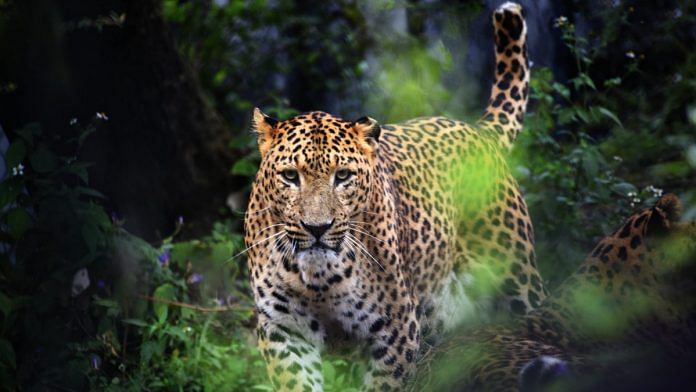When I met Faiyaz Khudsar, the scientist-in-charge of the Yamuna Biodiversity Park, his eyes were shining. ‘The park has succeeded in rewilding this area!’ he cried. ‘The highest trophic level has now been achieved. We have a top predator!’ His excitement was infectious. The Leopard was not just in the park, it was also hunting its natural prey of wild pig and deer. The area had come full circle—from a patch of barren, saline soil which wouldn’t even support grass, the park now had a flourishing ecosystem and the wild, pulsing endorsement of an elusive, large carnivore at the top of the food chain. This trophy had prowled quietly past villages and slipped in through the trees and grasses to the park where it had then settled, hunted, and become the part of the picture that had been missing so far—the thrill of a Big Cat. For most wildlife lovers, all wildlife is interesting to watch, but seeing a predator is a different kind of rush.
They say there is a difference in the way we perceive a carnivore versus a predator. A carnivore is an animal that eats meat. But it is not always meat that is pursued. It could be meat that is scavenged, dug up, found, or snatched from other carnivores. The small, enchanting and nocturnal Civet cat is a carnivore known to scavenge a great deal.
Predators like leopards are markedly different. They don’t just find their food; they chase it. Their paws tear at the earth as they run towards their prey—so fast they could be flying. When a predator arrives, all other wild animals resound in alarm. Even birds that are predators have a similar presence. If a Greater spotted eagle alights on a tree, pigeons or parakeets fly up and off in an electrified panic; crows caw urgently. The other animals feel an alertness that binds them together—that fear of being eaten by something faster or more driven than them. Sometimes predators are faster than their prey by just a whisker. At other times, they are masters and mistresses of surprise and ambush.
Also read: Why Indian leopards switched from ‘healthy salad’ to ‘risky junk’
This makes a predator seem wilder than any other form of wildlife. And thus, the staff at Yamuna Biodiversity Park rejoiced: they had their predator. And not just any predator, but an apex one that sat comfortably at the top of the food chain. A camera trap—a hidden camera that took pictures of animals that moved in front of it—took many images of the Leopard.
The photos of the Leopard were soon in the papers. Nature lovers were ecstatic. Debates on rewilding larger parts of the city started ricocheting through its corridors. Could Delhi reclaim older habitats, and raise forests, reedbeds and scrubland next to the entire length of the river Yamuna? Could it have leopards loping once again through the Ridge forests, which are marked with ancient Aravalli boulders, but ring with a resounding silence: the absence of megafauna and large predators? There had been leopards in Delhi before too, pushing from both ends of north and south Delhi, brushing other states. But they always slipped away from public memory or planning. Pugmarks had been found in a mushroom farm near Wazirabad before. But this time Delhi’s Leopard was on camera—immortalized, framed and recorded.
It was also perfect to be judged.
The first wave of protests came from people who lived next to the park. In no time, the group had made representations to the Aam Aadmi Party-led Delhi government. The demand was clear: remove the Leopard or lose support. Imran Hussain, the then environment minister of the AAP, made clear, unequivocal statements on the issue. The Leopard was going to be caught and moved either to a ‘forest’ or to a zoo. A cage with a goat as bait was set up.
This was declared as being done for the safety of the people, and the safety of the Leopard.
The chief wildlife warden of the city stated that the Leopard might have been ‘separated from its pack’. My response should not have been one of shock, but I felt surprised all the same. The image of the Sohna Leopard—the hissing spitfire, unforgiving and fearless—came to mind. Everything that was being said reeked of what can only be described as ecological illiteracy. Leopards are elusive, secretive and solitary. They don’t live in packs. The only big cats that live or move together are lions. And the minister’s statement that the Leopard was going to be caught for its safety made me choke. The last thing a wild leopard’s safety needs is capture. Catching a wild leopard may maim it for ever—through a botched operation, or the animal’s fury at being touched by human hands.
I requested a meeting with Imran Hussain to convince him to drop the idea of Leopard capture.
Also read: Everything should be done to ensure protection of forests, animal habitats, says PM Modi
In a room with white furniture, talking to the white-clad politician, I tried to tell the big cat’s story. ‘The Leopard will die if you take it to a zoo,’ I told him. ‘In fact, it will die a thousand deaths.’
‘Death? Who is talking about death?’ he replied equably, looking at me like I was a bit mad. ‘We are soft people. We will take a soft approach. We will give it an enclosure in a zoo. It will live there.’
I paused, wondering where to begin.
‘It will have food and lodging—usko khaane ke liye bhatakna nahi padega (It won’t have to look around for food),’ the minister’s aide added, finishing his boss’s thought.
They were describing the zoo as one would describe a hotel with a free and endless supply of food. Except that leopards don’t want these anthropogenic niceties. The Sohna Leopard returned to my mind, in bloody technicolour against the whiteness of the room.
‘If you put a wild leopard in a cage, it will smash its head against the bars and injure itself. They don’t take kindly to being caught,’ I told him. ‘And a wild leopard can never adapt to a life in captivity. It’s cruel to put it in a cage.’
I suggested a plan for avoidance behaviour for the villagers, chain-link fencing for portions of the village, connecting the park to more wildernesses near Yamuna Khadar so the Leopard could have a larger area to move in, and monitoring the animal through a radio-collar.
At the end of the meeting, Hussain agreed to put the leopard- baiting on hold. He said he would call me back for a meeting on Monday to decide the way forward.
The very next day, the Leopard was caught. It was then taken to a location that was never officially disclosed. The newspapers said it had been taken to the ‘Shivaliks near Saharanpur’.
Also read: Human exploitation is changing leopard behaviour, with genetic costs
The move was illegal. The Wild Life (Protection) Act, 1972, clearly states that a wild animal can only be captured if it has been proven to be a danger to human life. The Leopard had not attacked anyone. In fact, it had not even been caught from someone’s bedroom; it was in a designated green belt, a place designed to brim over with biodiversity. Each month in India, the forest department tries to catch leopards which go to places we think they shouldn’t—from schools (in Bangalore’s Whitefield in 2016), villages (Malady village in Kerala in 2018), and so on. But in this case, the Leopard was in a park meant for wildlife, and it was eating wild animals. The problem was altruistic: it was as if the cat needed to be punished for existing.
What was unfurling was also wrong procedure: The Wild Life (Protection) Act, 1972, says orders to catch or kill animals should be given by the chief wildlife warden. The Leopard is in Schedule I of the Wild Life (Protection) Act. On the issue of hunting or capturing a Schedule I animal, the Act says in Chapter III, Section 11 (a): wild and wilful
(a) the Chief Wild Life Warden may, if he is satisfied that any wild animal specified in Schedule I has become dangerous to human life or is so disabled or diseased as to be beyond recovery, by Order in writing and stating the reasons therefore, permit any person to hunt such animal or cause such animal to be hunted; [Provided that no wild animal shall be ordered to be killed unless the Chief Wild Life Warden is satisfied that such animal cannot be captured, tranquilised or translocated: Provided further that no such captured animal shall be kept in captivity unless the Chief Wild Life Warden is satisfied that such animal cannot be rehabilitated in the wild and the reasons for the same are recorded in writing.
The fact that a minister, not an authorized forest official, was making these announcements, laid bare what leopards face all over India: decisions that are political, not ecological, and judgements that see leopards as pests, not subjects or living beings with importance in their own right.
 This excerpt from ‘Wild and Wilful’ by Neha Sinha has been published with permission from HarperCollins India.
This excerpt from ‘Wild and Wilful’ by Neha Sinha has been published with permission from HarperCollins India.




so should we wait for several human deaths before taking any action to segregate a wild beast found near any human settlement
Bio diversity should be a mandatory subject in all education system. If not there might be no future generations.